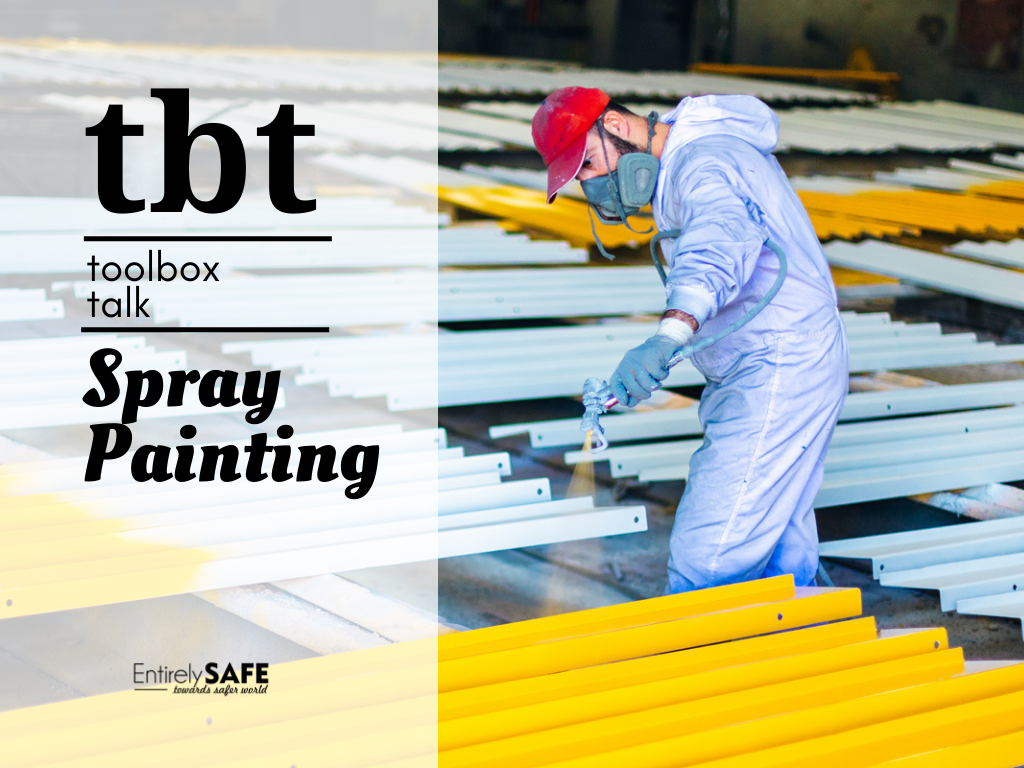Spray Painting Toolbox Talk

Before the Toolbox Talk
This safety talk is designed for discussion leaders to use in preparing safety meetings. Set a specific time and date for your safety meeting. Publicize your meeting so everyone involved will be sure to attend. Review this safety talk before the meeting and become familiar with its content.
Make notes about the points made in this talk that pertain to your workplace. You should be able to present the material in your own words and lead the discussion without reading it.
Seating space is not absolutely necessary, but arrangements should be made so that those attending can easily see and hear the presentation. Collect whatever materials and props you will need ahead of time. Try to use equipment in your workplace to demonstrate your points.
Give the safety talk in your own words. Use the printed talk merely as a guide. The purpose of a safety meeting is to initiate a discussion of safety problems and provide solutions to those problems. Encourage employees to discuss hazards or potential hazards they encounter on the job. Ask them to suggest ways to improve safety in their area. Don’t let the meeting turn into a gripe session about unrelated topics. As a discussion leader, it’s your job to make sure the topic is safe. Discussing other topics wastes time and can ruin the effectiveness of your safety meeting.

Toolbox Talk: Spray Painting
We know that spray painting is done at a specially constructed and ventilated booth or in the open using a hand spray gun.
When we use the term ‘Paint’ we include lacquer, varnish, or other coatings used in the spray gun. We must concern ourselves with our own personal protection from breathing hazardous fumes and vapors, or in many instances from fire or explosion.
Spray booths must be exhausted so that fresh air moves from the worker to the exhaust outlet in a manner that avoids harmful concentrations of particles or toxic or harmful fumes or vapors. It is up to us to see that this flow is not interfered with and that we are wearing the proper type of respirator for the materials being used. In small booths the linear air movement must be at least 100 feet per minute; in larger booths, the rate is at least 150 linear feet per minute.
This movement should be monitored constantly with gauges. In some cases, a respirator helmet fed by an airline may have to be worn by the operator. Let’s discuss some often overlooked safety precautions. Any source of unusual heat is very dangerous. Electrical extension cords, even temporary ones, should never be permitted in or around paint spray booths.
Anything that might generate a spark or an electric arc should be repaired or removed. Unenclosed light bulbs can become quite hot and reach temperatures that could set off an explosion under certain conditions and with certain materials.
One of the more rare considerations that must at least be investigated is whether an agent is present that can, during extended periods of exposure, be absorbed through the skin. A check of threshold limit values will serve as a guide in making this determination. In most cases, the manufacturers will label the containers, listing the ingredients, or they will furnish the user with such a list. Strict attention to what we have discussed and the use of common sense will safeguard us from the hazards of spray paint.
Interactive Discussion
- Have you or someone you know been injured or nearly injured while carrying out this activity? What happened?
- How can we stay safe today?
- What do we do at the worksite to prevent injuries related to this activity?
After the Toolbox Talk
At the end of the meeting, ask employees to sign a sheet on the back of this talk as a record that they attended the safety meeting. Keep this talk on file for your records.

